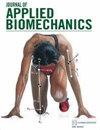The Nonintuitive Contributions of Individual Quadriceps Muscles to Patellar Tracking.
IF 1.1
4区 医学
Q4 ENGINEERING, BIOMEDICAL
Journal of Applied Biomechanics
Pub Date : 2022-07-01
Print Date: 2022-08-01
DOI:10.1123/jab.2021-0112
引用次数: 1
Abstract
The purpose of this study was to quantify the contribution of the individual quadriceps muscles to patellar tracking. The individual and/or combined quadriceps muscles were activated in rabbits (n = 6) during computer-controlled flexion/extension of the knee. Three-dimensional patellar tracking was measured for the vastus lateralis, vastus medialis, and rectus femoris when activated alone and when activated simultaneously at different frequencies, producing a range of knee extensor torques. Patellar tracking changed substantially as a function of knee extensor torque and differed between muscles. Specifically, when all quadriceps muscles were activated simultaneously, the patella shifted more medially and proximally and rotated and tilted more medially compared with when vastus lateralis and rectus femoris were activated alone (P < .05), whereas vastus medialis activation alone produced a similar tracking pattern to that observed when all quadriceps muscles were activated simultaneously. Furthermore, patellar tracking for a given muscle condition shifted more medially and proximally and rotated and tilted more medially with increasing knee extensor torques across the entire range of knee joint angles. The authors conclude that patellar tracking depends crucially on knee extensor force/torque and that vastus medialis affects patellar tracking in a distinctly different way than vastus lateralis and rectus femoris, which produce similar tracking patterns.单个股四头肌对髌骨追踪的非直觉贡献。
本研究的目的是量化单个股四头肌对髌骨追踪的贡献。在计算机控制的膝关节屈伸过程中,兔(n = 6)单个和/或联合股四头肌被激活。在单独激活和以不同频率同时激活时,测量股外侧肌、股内侧肌和股直肌的三维髌骨跟踪,产生一定范围的膝关节伸肌扭矩。髌骨跟踪随着膝关节伸肌扭矩的变化而发生了实质性的变化,并且在不同肌肉之间有所不同。具体而言,与股外侧肌和股直肌单独激活相比,当所有股四头肌同时激活时,髌骨向内侧和近端移动更多,向内侧旋转和倾斜更多(P < 0.05),而单独激活股内侧肌与所有股四头肌同时激活时观察到的跟踪模式相似。此外,在整个膝关节角度范围内,随着膝关节伸肌扭矩的增加,给定肌肉状况的髌骨跟踪向内侧和近端移动更多,向内侧旋转和倾斜更多。作者得出结论,髌骨追踪关键取决于膝关节伸肌力/扭矩,股内侧肌影响髌骨追踪的方式明显不同于股外侧肌和股直肌,两者产生相似的追踪模式。
本文章由计算机程序翻译,如有差异,请以英文原文为准。
求助全文
约1分钟内获得全文
求助全文
来源期刊

Journal of Applied Biomechanics
医学-工程:生物医学
CiteScore
2.00
自引率
0.00%
发文量
47
审稿时长
6-12 weeks
期刊介绍:
The mission of the Journal of Applied Biomechanics (JAB) is to disseminate the highest quality peer-reviewed studies that utilize biomechanical strategies to advance the study of human movement. Areas of interest include clinical biomechanics, gait and posture mechanics, musculoskeletal and neuromuscular biomechanics, sport mechanics, and biomechanical modeling. Studies of sport performance that explicitly generalize to broader activities, contribute substantially to fundamental understanding of human motion, or are in a sport that enjoys wide participation, are welcome. Also within the scope of JAB are studies using biomechanical strategies to investigate the structure, control, function, and state (health and disease) of animals.
 求助内容:
求助内容: 应助结果提醒方式:
应助结果提醒方式:


